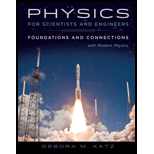
Concept explainers
In the short story The Pit and the Pendulum by 19th-century American horror writer Edgar Allen Poe, a man is tied to a table directly below a swinging pendulum that is slowly lowered toward him. The “bob” of the pendulum is a 1-ft steel scythe connected to a 30-ft brass rod. When the man first sees the pendulum, the pivot is roughly 1 ft above the scythe so that a 29-ft length of the brass rod oscillates above the pivot (Fig. P16.39A). The man escapes when the pivot is near the end of the brass rod (Fig. P16.39B). a. Model the pendulum as a particle of mass ms 5 2 kg attached to a rod of mass mr 5 160 kg. Find the pendulum’s center of mass and rotational inertia around an axis through its center of mass. (Check your answers by finding the center of mass and rotational inertia of just the brass rod.) b. What is the initial period of the pendulum? c. The man saves himself by smearing food on his ropes so that rats chew through them. He does so when he has no more than 12 cycles before the pendulum will make contact with him. How much time does it take the rats to chew through the ropes?

FIGURE P16.39
(a)
The center of mass and the rotational inertia around an axis through its center of mass.
Answer to Problem 39PQ
The center of mass and the rotational inertia around an axis of the pendulum through its center of mass. are
Explanation of Solution
Write the expression for the center of mass of the entire pendulum.
Here,
To find the pendulum’s rotational inertia around its center of mass , add the rods rotational inertia plus the particles rotational inertia. The particles distance from the center of mass is
Here,
To find the
Here,
According to parallel axis theorem, the rotational inertia around the pendulums center of mass can be calculated.
Here,
Write the expression for the moment of inertia.
Use equation (V) in equation (III),
Use equation (III) in equation (IV),
Conclusion:
Substitute
Substitute
Substitute
Therefore, the center of mass and the rotational inertia around an axis of the pendulum through its center of mass. are
(b)
The initial period of the pendulum.
Answer to Problem 39PQ
The initial period of the pendulum is
Explanation of Solution
Write the expression for the period of the pendulum.
Here,
Write the expression for the angular frequency of a physical pendulum.
Here,
The pendulum is a physical pendulum, the distance between the pivot and the center of mass can be found out from the figure given below.
The rotational inertia of the pendulum around the pivot is given by,
Conclusion:
Substitute
to find
Substitute
Substitute
Therefore, The initial period of the pendulum is
(c)
The time taken for the rats to chew through the ropes.
Answer to Problem 39PQ
The time taken for the rats to chew through the ropes is
Explanation of Solution
Write the expression for the period of the pendulum.
Here,
Write the expression for the angular frequency of a physical pendulum.
Here,
The pendulum is a physical pendulum, the distance between the pivot and the center of mass can be found out from the figure given below.
The rotational inertia of the pendulum around the pivot is given by,
Conclusion:
Substitute
To find
Substitute
Substitute
The rats have 12 cycles to chew through the rope or the corresponding tome is,
Therefore, The time taken for the rats to chew through the ropes is
Want to see more full solutions like this?
Chapter 16 Solutions
Webassign Printed Access Card For Katz's Physics For Scientists And Engineers: Foundations And Connections, 1st Edition, Single-term
- help and explain how to find the answerarrow_forwardWhat is the equivalent resistance between points A and B of the network shown in the figure? A • 12 B 4.0 6.0 Ω 8.0 Ωarrow_forwardAccording to the provided information answer the question accorrding to grade 11 physics Jerry has decided to give up his part-time job for a new career, cat-burglar! Jerry loves the idea of dressing up like a cat all day and of course the chance of meeting Cat Woman! On Jerry's first "job" he figures out his escape plan. He travels 3.0 km south for 15 minutes and then 8.0 km west for 1.5 hours before reaching his house. Draw a sketch diagram of the path he took with all the appropriate labels.arrow_forward
 University Physics Volume 1PhysicsISBN:9781938168277Author:William Moebs, Samuel J. Ling, Jeff SannyPublisher:OpenStax - Rice University
University Physics Volume 1PhysicsISBN:9781938168277Author:William Moebs, Samuel J. Ling, Jeff SannyPublisher:OpenStax - Rice University Physics for Scientists and Engineers: Foundations...PhysicsISBN:9781133939146Author:Katz, Debora M.Publisher:Cengage Learning
Physics for Scientists and Engineers: Foundations...PhysicsISBN:9781133939146Author:Katz, Debora M.Publisher:Cengage Learning Modern PhysicsPhysicsISBN:9781111794378Author:Raymond A. Serway, Clement J. Moses, Curt A. MoyerPublisher:Cengage Learning
Modern PhysicsPhysicsISBN:9781111794378Author:Raymond A. Serway, Clement J. Moses, Curt A. MoyerPublisher:Cengage Learning Classical Dynamics of Particles and SystemsPhysicsISBN:9780534408961Author:Stephen T. Thornton, Jerry B. MarionPublisher:Cengage Learning
Classical Dynamics of Particles and SystemsPhysicsISBN:9780534408961Author:Stephen T. Thornton, Jerry B. MarionPublisher:Cengage Learning Principles of Physics: A Calculus-Based TextPhysicsISBN:9781133104261Author:Raymond A. Serway, John W. JewettPublisher:Cengage Learning
Principles of Physics: A Calculus-Based TextPhysicsISBN:9781133104261Author:Raymond A. Serway, John W. JewettPublisher:Cengage Learning Physics for Scientists and EngineersPhysicsISBN:9781337553278Author:Raymond A. Serway, John W. JewettPublisher:Cengage Learning
Physics for Scientists and EngineersPhysicsISBN:9781337553278Author:Raymond A. Serway, John W. JewettPublisher:Cengage Learning





